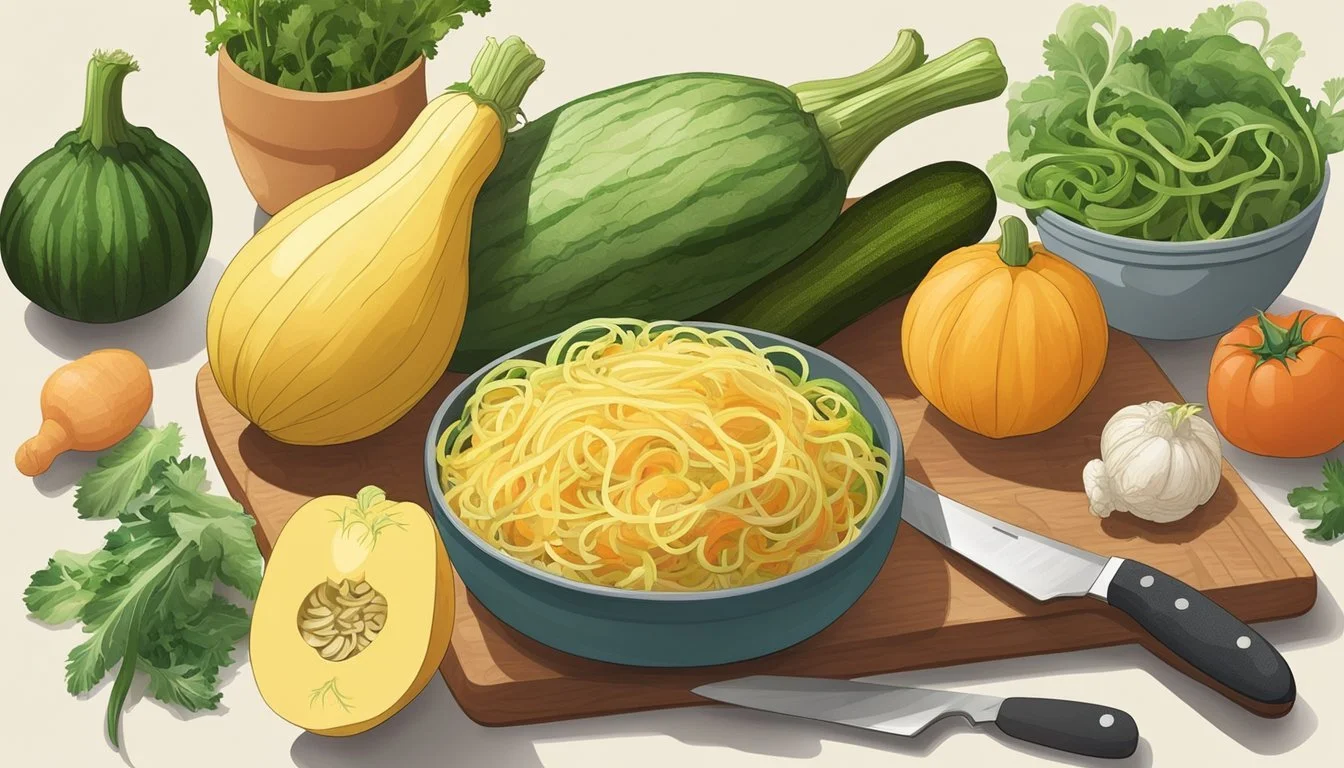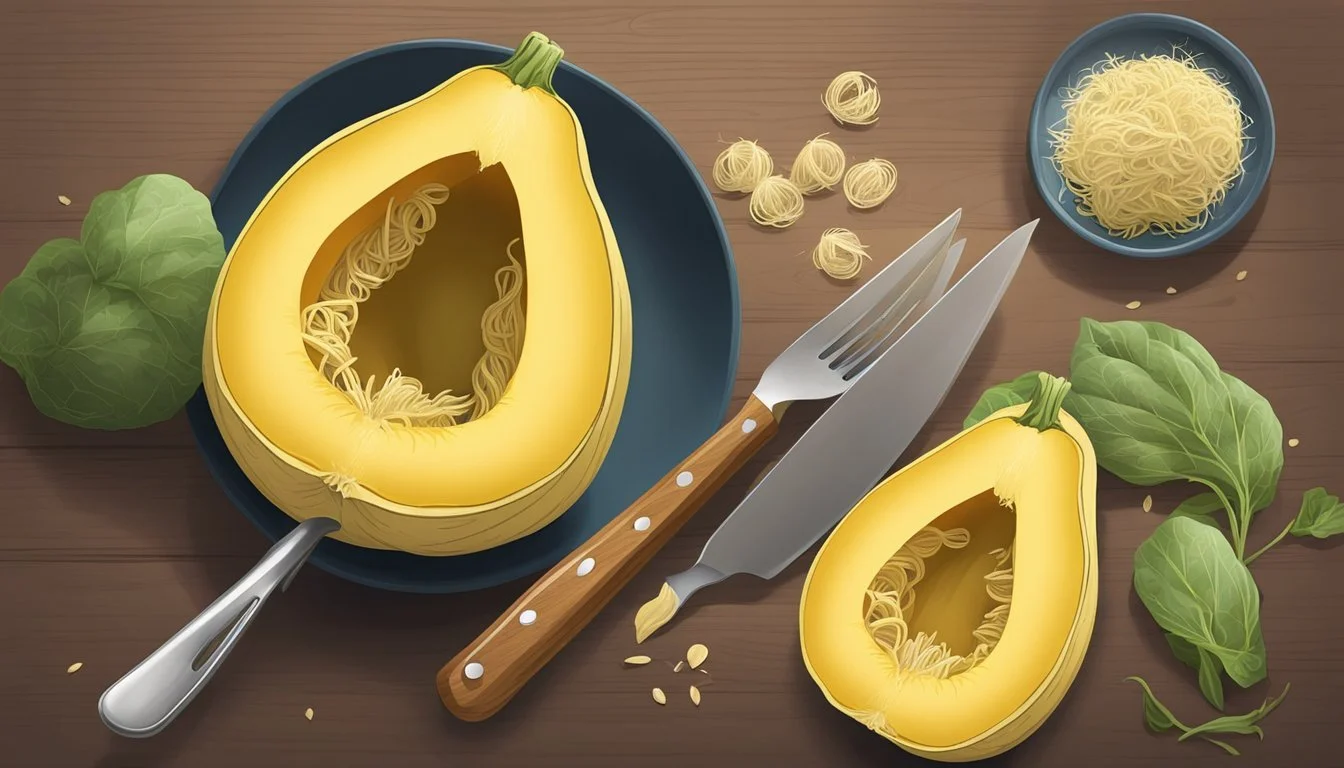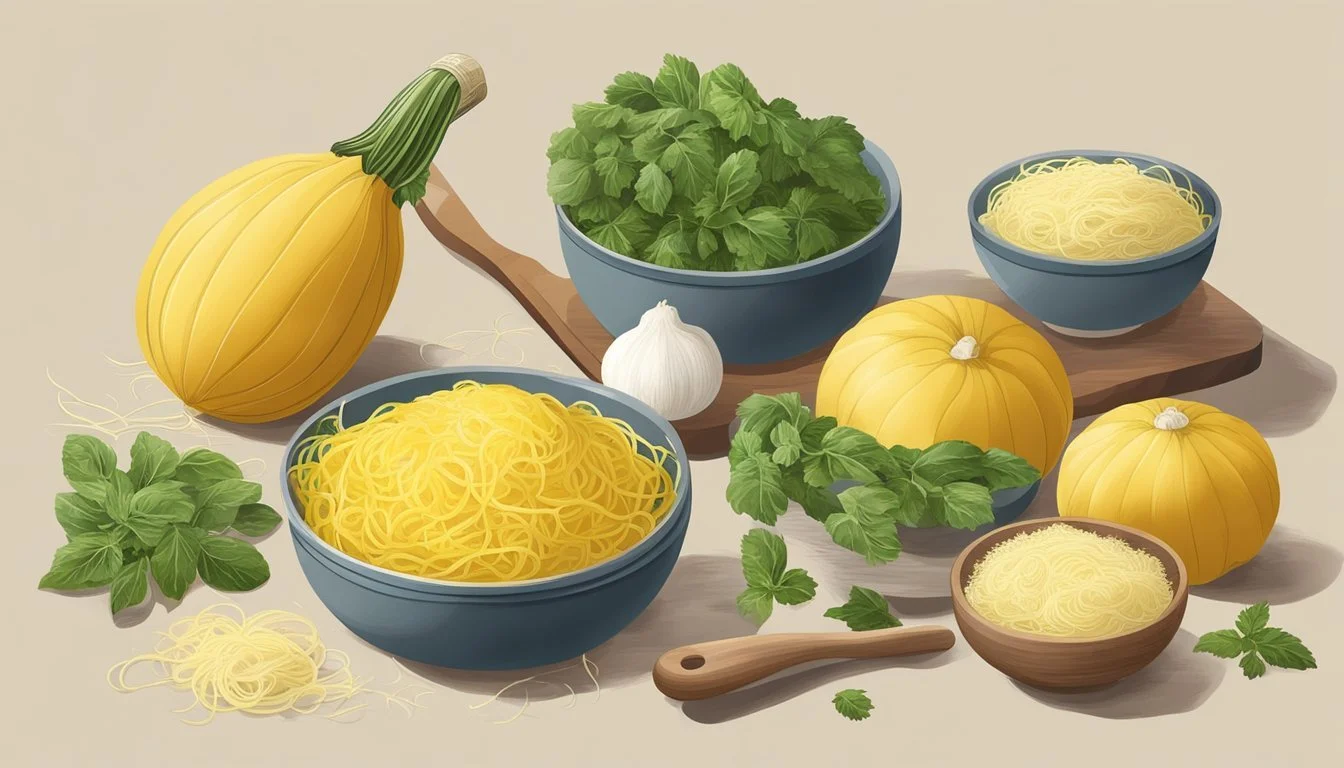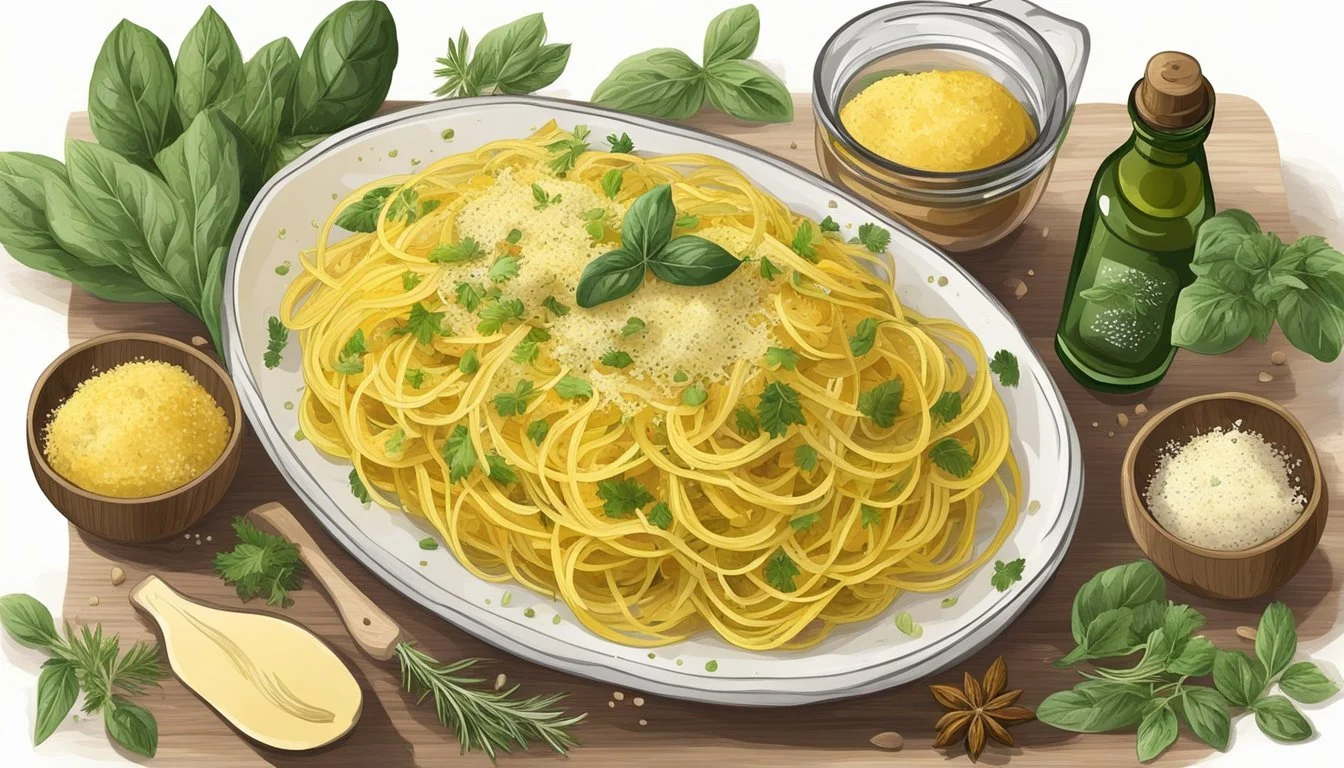Spaghetti Squash Substitutes
Top Alternatives for Low-Carb Diets
Spaghetti squash presents a nutritious alternative to traditional pasta (What wine goes well with pasta?) that caters to a variety of dietary needs, including low-carb and gluten-free diets. Recognizable by its oblong shape and pale-yellow to medium-yellow skin, when cooked, its flesh separates into strands reminiscent of spaghetti, hence its name. This unique vegetable offers a mildly sweet and nutty flavor that easily absorbs the sauces and seasonings it's paired with, making it an adaptable ingredient in the kitchen.
While spaghetti squash is a healthy option for those looking to decrease their carbohydrate intake, it’s not the only substitute available for pasta lovers. Zucchini can be transformed into 'zoodles' using a spiralizer or julienne peeler, providing a similar texture and neutral taste profile. These substitutes not only mimic the experience of eating traditional noodles but also enhance the nutritional value of the dishes they're used in.
Ideal for individuals seeking healthy alternatives without sacrificing the enjoyment of a pasta-like dish, these substitutes blend seamlessly into recipes. They offer an opportunity to explore a variety of flavors and textures while maintaining a balanced diet. Each substitute carries with it a unique set of benefits, and choosing one will depend on nutritional goals, desired texture, and flavor preference.
The Basics of Spaghetti Squash
Spaghetti squash is a versatile ingredient that can be a nutritious addition to meals, providing a gluten-free substitute for pasta with its unique texture. Understanding its nutritional profile and culinary properties is essential for anyone looking to incorporate it into their diet.
Nutritional Profile
Spaghetti squash is low in calories but high in fiber, vitamins, and minerals, making it an excellent choice for nutrient-dense, low-calorie diets. Here is a brief overview of its nutritional content per serving:
Calories: Approximately 42 kcal
Fiber: About 2.2 grams, which aids digestion
Protein: 1 gram per cup, contributing to muscle health
Vitamins: Rich in vitamin C, B6, and niacin
Minerals: Contains magnesium and potassium, supporting overall body functions
Culinary Properties
The culinary appeal of spaghetti squash lies in its texture and flavor. When cooked, the flesh pulls apart into spaghetti-like strands, offering a unique, gluten-free alternative to traditional pasta. Its cooking process is straightforward:
Texture: Tender yet firm, resembling al dente pasta
Flavor: Mild and slightly sweet, with a neutral flavor that pairs well with a variety of sauces and seasonings
Cooking method: Typically baked in an oven; the squash is halved, seeds are removed, and it's cooked until the interior is easily shredded with a fork
To summarize, spaghetti squash can enhance a recipe by adding essential nutrients without overpowering other ingredients with its mild taste. It’s well-suited for those seeking a gluten-free option that's high in fiber and boasts a variety of vitamins and minerals. Its ability to mimic the texture of pasta makes it a popular choice in many dishes.
Popular Spaghetti Squash Substitutes
When seeking an alternative to spaghetti squash, a variety of vegetables can serve as noodle replacements offering both flavor compatibility and textural similarity. These substitutes are ideal for those following a low-carb or gluten-free diet and are typically lower in calories.
Zucchini Noodles (Zoodles)
Zucchini can be transformed into "zoodles" or zucchini noodles using a spiralizer. This alternative provides a similar texture to spaghetti squash and is suitable for those looking for a low-calorie, gluten-free noodle replacement. Zucchini noodles are versatile, holding up well in stir-fries and with an array of sauces.
Spiralized Vegetables
Beyond zucchini, a range of vegetables can be spiralized to create noodle-like ribbons. Carrots, beets, and sweet potatoes are commonly used for their sturdiness and flavor. These spiralized veggies can be used just as traditional noodles would be, from baking to sautéing, making them a flexible option in many recipes.
Shirataki Noodles
Shirataki noodles, composed mostly of water and glucomannan (a fiber from the konjac plant), are a unique substitute. They are virtually free of calories and carbs, aligning well with low-carb diets. Shirataki noodles come ready to eat and only need to be warmed, making them a convenient option for quick meals.
Butternut Squash
Butternut squash, when baked, can be used as a spaghetti squash substitute due to its mildly sweet flavor and firm texture. It can be peeled, seeded, and then sliced into thin ribbons with a spiralizer or cut into cubes and roasted. Butternut squash pairs well with a variety of spices and sauces, offering a nutritious addition to meals.
Dishes That Can Use Substitutes
When opting to replace spaghetti squash in various dishes, there are several viable substitutes that suit a range of meals from healthy pasta dishes (What wine goes well with pasta dishes?) to innovative salads and classic comfort foods. These alternatives not only preserve the integrity of the original dish but also may offer additional health benefits.
Healthy Pasta Alternatives
For those seeking low-carb pasta alternatives, zucchini can be transformed into "zoodles" with a spiralizer to mimic spaghetti squash. Chickpea pasta offers a gluten-free option rich in protein and fiber, suitable for traditional pasta dishes like baked ziti. Soba noodles, made from buckwheat, are another nutritious choice, providing fewer carbs and a richer profile of antioxidants compared to standard pasta.
Recipes: Baked ziti with chickpea pasta, soba noodle stir-fry
Sauces: Tomato, pesto, or cream-based sauces pair well
Butter: A dollop of butter can enhance the flavor of noodles
Creative Salad Additions
Chopped or spiralized veggies such as zucchini or carrots offer a crunchy, nutrient-dense substitution for spaghetti squash in salads. These vegetables can absorb dressings well and contribute additional vitamins and antioxidants. Including these pasta alternatives in salads provides a fulfilling and health-conscious meal.
Salad: Mediterranean veggie salad, Asian-inspired noodle salad
Dressing: Opt for olive oil and vinegar-based dressings to complement the veggies
Comfort Food Makeovers
For a healthier take on comfort foods like lasagna or meatballs, consider using layers of thinly sliced zucchini or incorporate gluten-free pasta alternatives. These options reduce the carb content while still satisfying the cheese and butter richness typically associated with comfort food. This approach maintains the heartiness of the dish while offering a more balanced nutritional profile.
Comfort Foods: Zucchini lasagna, meatballs with gluten-free spaghetti
Cheese: Use ricotta or mozzarella for a traditional touch in lasagna
Cooking Tips and Tricks
Exploring the realms of cooking spaghetti squash, one encounters the challenge of retaining freshness and flavor, particularly when dealing with leftovers or aiming for that ideal texture. These tips are dedicated to making the most of this versatile vegetable.
Utilizing Leftovers
One often encounters leftover spaghetti squash in the kitchen. For optimal use, leftovers should be stored in an airtight container and can be refrigerated for up to 5 days. Spaghetti squash lovers can rejuvenate leftovers by sautéing them in a pan with a touch of olive oil or by incorporating them into a frittata or a warm salad. This not only prevents waste but also provides an opportunity to get creative with recipes.
Refrigerate leftover squash within 2 hours of cooking.
Reheat gently, adding a sprinkle of water to avoid dryness.
Achieving the Perfect Texture
Texture is crucial when cooking spaghetti squash, as it can easily become mushy. To achieve a 'noodle-like' texture, one must avoid overcooking.
When baking, halve the squash and brush with oil; bake cut-side down.
To determine doneness, fork-test the flesh; it should be tender.
If excess liquid is a concern, letting the cooked squash rest allows for some to be absorbed or evaporated.
Cooking spaghetti squash requires a balance between maintaining enough moisture for a pleasant mouthfeel and reducing liquid to achieve the correct firmness. This is easily managed with attention to cooking time and temperature.
Cooking Time: Approximately 30-40 minutes at 375°F (190°C).
Drain well if squash seems watery after cooking.
Special Dietary Considerations
In the context of dietary needs, alternatives to spaghetti squash should align with gluten-free requirements and the pursuit of lower carbs and calories.
Gluten-Free Options for Celiac Disease
For individuals with celiac disease, substituting spaghetti squash with gluten-free options is crucial for health and well-being. Zucchini noodles, also known as zoodles, stand out as an excellent choice. Crafted using a spiralizer, they provide a pasta-like experience with no gluten present.
Lowering Carbs and Calories
Reducing carbohydrate intake and managing caloric content is often a priority for a low-carb diet. Spaghetti squash itself is lauded for its low-carb and low-calorie profile, making it ideal for those monitoring their intake. For those seeking an alternative, zucchini again proves beneficial. Here's a brief comparison based on a 100g serving:
Vegetable Carbs Calories Fiber Spaghetti Squash 7g 31 kcal 1.5g Zucchini 3g 17 kcal 1g
Opting for zucchini as a substitute can help in maintaining a balanced diet with reduced carbs and calories.
Supplemental Ingredients to Enhance Flavor
When considering substitutes for spaghetti squash, it's essential to complement these alternatives with the right blend of flavors that not only mimic traditional pasta dishes but also add a unique zest. Choosing herbs, spices, and various add-ins can elevate the dish.
Herbs and Spices
The judicious use of herbs and spices can significantly enhance the natural flavor of spaghetti squash substitutes. Consider these combinations:
Italian Flavors: Mix dried or fresh herbs like oregano, basil, and thyme for a classic profile.
Zesty Lift: A squeeze of lemon juice and zest adds brightness, especially to zucchini noodles.
For each flavor profile, use the following guide:
Flavor Profile Herbs and Spices Recommended Quantity Italian Oregano, Basil, Thyme 1 tsp dried or 1 tbsp fresh each Zesty Lemon Juice and Zest 1 tbsp juice, 1 tsp zest
Adding Proteins and Vegetables
Incorporating protein and vegetables can transform a simple substitute into a hearty meal. Consider these options:
Proteins: Grilled chicken or tofu can add substance, making the dish more satisfying.
Vegetables: Roasted cauliflower, caramelized onions, sautéed broccoli, or eggplant can add depth of flavor and nutritional benefits. Roasting beets alongside the substitute can imbue sweet and earthy notes.
Here are a few specific pairings:
Substitute Protein Vegetables Zucchini Grilled Chicken Caramelized Onions, Broccoli Cauliflower Tofu Eggplant, Beets
When adding cheese, opt for varieties that melt well and complement the dish's overall flavor, such as mozzarella or Parmesan. Sauces can range from a classic marinara to a creamy Alfredo, depending on the desired richness and taste.
Conclusion
Identifying suitable alternatives to spaghetti squash aligns with the mission to provide diverse options for dietary preferences and requirements. Various substitutions are available, depending on the desired texture, flavor, and nutritional content.
Popular Substitutes:
Zucchini Noodles: Also known as 'zoodles', they are a popular low-carb choice with a neutral flavor, easily created using a spiralizer.
Sweet Potatoes: They offer a sweet flavor and a firmer texture, suitable for baking or boiling.
Butternut Squash: With a similar consistency, butternut squash can replace spaghetti squash in many recipes while adding a slightly sweeter taste.
Eggplant: With its meaty texture, eggplant can be a hearty, low-carb alternative when diced or cut into strips.
Factors to Consider:
Texture and Consistency: Squashes tend to offer a firmer, pasta-like consistency.
Taste Preferences: Some substitutes add a sweet or distinct flavor to dishes.
Availability: Certain substitutions may be more readily available based on seasonal produce.
When commissioning a meal that traditionally includes spaghetti squash, chefs and home cooks can confidently explore these substitutions, tailoring dishes to individual tastes and nutritional goals. Each substitute offers a unique contribution to both the palate and the plate, ensuring a satisfying culinary experience.





